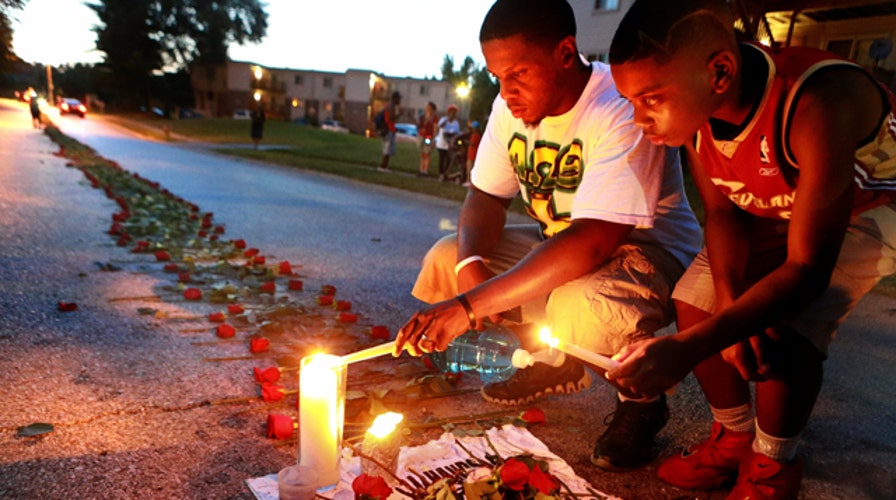Dr. Baden vs. official Michael Brown autopsy report
Leaked findings could be at odds with those of private autopsy conducted by famed former New York City Chief Medical Examiner Michael Baden. #Ferguson
This is a rush transcript from "On the Record," October 22, 2014. This copy may not be in its final form and may be updated.
KIMBERLY GUILFOYLE, 'ON THE RECORD' GUEST HOST: Right now, new information about the police shooting of a teen that sparked days of riots in Ferguson, Missouri. Autopsy results on Michael Brown reportedly show Brown was shot in the hand at close range.
Back in August, Dr. Michael Baden performed a separate autopsy on Brown, so does he agree with the new report? Dr. Baden joins you now. We are going to ask him.
DR. MICHAEL BADEN, FORENSIC PATHOLOGIST: Hi, Kimberly.
GUILFOYLE: Hi. Great to have you here tonight.
BADEN: Yeah. I think the new report that's been release from the first autopsy is -- I agree with much of what it said in there. There is evidence of a wound being inflicted while his hand was in the car at least because he does have a gunshot graze wound in the hand, the right hand.
GUILFOYLE: The decedent, Michael Brown?
BADEN: The decedent, yes. And his blood was found by the FBI in the car. So, that, I think, is agreed upon. There is some gunshot residue in the hand, only seen under the microscope. It wasn't seen the first autopsy on the skin surface but under the skin.
GUILFOYLE: Again, on Michael Brown. So that's GSR, gunshot residue, which would suggest that he was in close proximity with the weapon, right, of the officer?
BADEN: Right, yes. So, and that gun shot wound of the car would fit that description.
GUILFOYLE: Would be consistent with that.
BADEN: I have seen newspapers of various speculations about how many gunshot wounds, the first and second autopsy agree that there were at least six bullets that struck Michael Brown.
GUILFOYLE: OK. So six shots that actually penetrated, but we don't know how many total shots were fired.
BADEN: We don't know how many total shots were fired and there were two perforations that were reentries from the six that were fired, two were reentered into the chest and heart. So that's all in agreement. Now, there's a third autopsy that was done under federal jurisdiction, which we don't have information.
GUILFOYLE: But you were privy to the results from the first autopsy and then, of course, you performed the second?
BADEN: I was privy.
GUILFOYLE: Before at all.
BADEN: Part of the problem. One of the reasons the family was concerned about a cover-up and was they weren't getting any information from the first autopsy. It's just two months now -- two months that they're finally getting some.
GUILFOYLE: Did you make a request to the authorities to be able to he see the first autopsy prior to you performing the second autopsy?
BADEN: I was called in after the first autopsy by the family and did I speak to the Dr. Mary Case who had done the first autopsy. She is a first rate forensic pathologist, but did I not see the first autopsy.
GUILFOYLE: You didn't see it but you had a conversation with her regarding the content?
BADEN: Briefly.
GUILFOYLE: Briefly.
BADEN: Because she was under some stricture from the prosecutor not to talk about it very much. She has not done since because of the ongoing grand jury, which should be over soon.
GUILFOYLE: OK, so based on what you know, what we know tonight of this report coming out, with the GSR, with the blood in the car, the close range, would you be surprised if the grand jury declined to return an indictment against the officer?
BADEN: Well, I wouldn't be surprised. I wouldn't be surprised.
(CROSSTALK)
BADEN: Just in general -- in general, all the shootings. It is very rare for a grand jury to indict a police officer who shoots somebody in the course of duty and this we'll see what happens here.
GUILFOYLE: At what point, are you supposed to keep shooting or stop?
BADEN: Stop and also to see what kind of injuries the police officer had. We don't know that yet.
GUILFOYLE: We don't know yet that yet tonight. Dr. Baden, thank you so much for being with us.
BADEN: Thanks, Kimberly.

